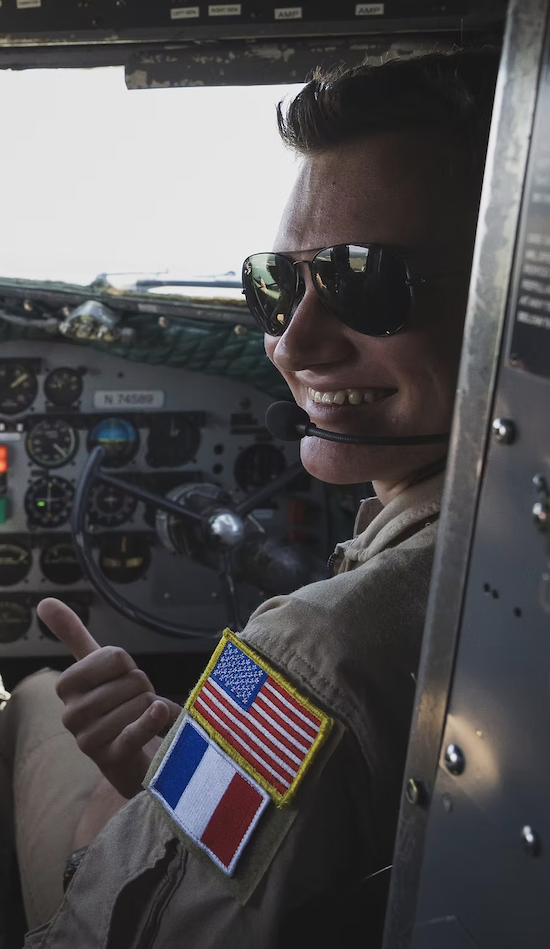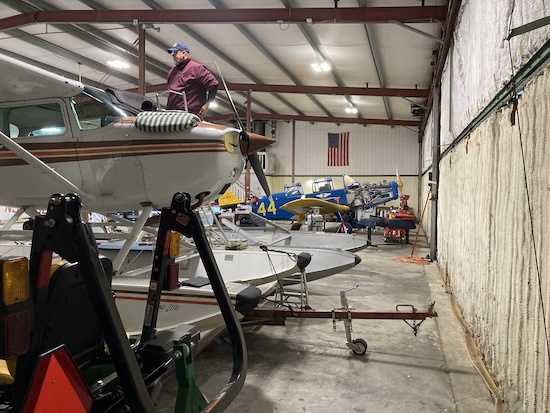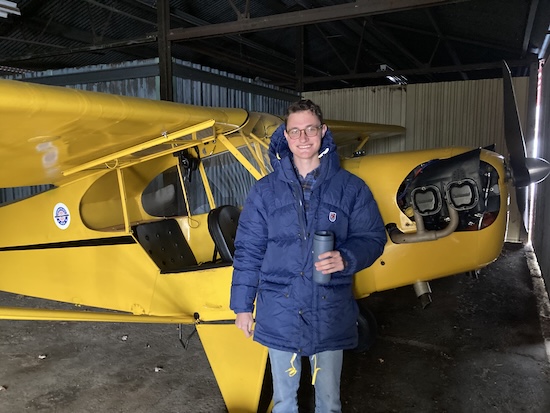
For about half of every week, Luc Zipkin ’26 lives like any other student—eating at Swings, attending classes, and socializing with his peers. The other half of the week, Zipkin revs up his self-built 1964 Land Rover Series IIA and drives 20 minutes to Goodspeed Airport in East Haddam, Conn. to run Goodspeed Flying Service, Zipkin’s self-owned flight instruction school.
Zipkin, who has had a pilot’s license since age 17 and an instructor’s license since age 18, started the school in 2023, the fall of his sophomore year at the University. He teaches his students, ranging from teenagers to experienced commercial pilots, how to fly a 1967 Citabria tailwheel, a three-wheeled, two-seat propeller plane.
Although the Citabria is leased from a maintenance shop at the same airport, Zipkin also keeps his own aircraft, a 1946 Piper Cub, in one of the airport’s 36 hangars.
Zipkin didn’t become a pilot out of nowhere; his grandfather, a World War II veteran, learned to fly with a plane he bought through the Servicemen’s Readjustment Act of 1944, commonly known as the G.I. Bill. Eric and David Zipkin, Luc’s father and uncle, own Tradewind Aviation, a private air travel company. Flying has been a part of his life for as long as Zipkin can remember. He started helping around the family business at six years old, and his first time in a plane, he says, predates his first memories.
Goodspeed Airport was purchased and revitalized in 2020 by a consortium of local pilots including Zipkin’s family and Bill McEnery, the owner of Pedal Power in Middletown, Conn. I drove to Goodspeed with Zipkin the morning after a light snowfall in February. A snowplow was clearing parts of the grounds. The runway sits just dozens of feet away from the Connecticut River, although the opposite bank was barely visible. Zipkin says that the weather disrupts flights about 50% of the time in the winter and 25% of the time in the summer. When the skies are clear, seaplanes can take off from the river, revealing a breathtaking view of the Connecticut landscape. Another tenant of the airport runs a seaplane instruction business.
The planes that Zipkin flies are small, barely reaching head height, and almost frighteningly simple: Much of their bodies are made from thick fabric stretched taut over steel tubes. Zipkin describes instruction as a psychological as much as a technical undertaking: Though he can correct student errors during a flight, they must learn to not rely on that failsafe.

“One woman described me as the world’s cheapest therapist,” Zipkin said.
That being said, flight lessons are not much cheaper than therapy. Zipkin charges $75-100/hr for lessons ($50 for Wesleyan students), which he says is one of the lowest rates in the state. Official statistics on the cost of flight lessons are hard to find, but aviation enthusiasts online agree that flight instruction prices have doubled or tripled in the past few decades.
Throughout our conversations, Zipkin bemoaned the common perception that general aviation (a term encompassing everything that is not commercial aviation) is a disappearing community. Much of this comes from flight instruction being seen as a luxury good.
Cost, however, is not the sole culprit: Zipkin also points to what he sees as a slowing fascination with mechanical objects like airplanes, which he describes as a pioneer interest. Many of those who do still have an interest in mechanical hobbies, he says, cannot afford to take lessons.
At Goodspeed, though, general aviation seems to be a thriving enterprise. All the airport’s hangars are occupied—one of them by a local band that found hangar space to be cheaper than studio space—and there is a three-year waiting list. Pilots that don’t rent hangars can still use the airport, with a suggested $10 landing fee.
“We have a really great community here,” Zipkin said. “There’s a lot of people in general aviation that believe it’s a dying business…but this place is proof that a public passion for general aviation is not dead.”

While at the airport, Zipkin brought me into the maintenance shop, leaving me to look around while he met with a mechanic. Three planes were being worked on, including one seaplane and one World War II-era plane belonging to the Commemorative Air Force (CAF), a decentralized organization that preserves and flies old combat aircraft. The plane, a Fairchild PT-26, was used to train fighter pilots during World War II.
Zipkin has flown for the CAF, most notably joining his father in a crew that flew World War II-era troop carriers, Douglas C-47s, back to Europe for the 80th anniversary of D-Day. Flying in a plane nicknamed “Placid Lassie,” which belongs to the Tunison Foundation, an aviation museum founded by Zipkin’s father, the trip took 10 days, with stops in Newfoundland, Iceland, and Scotland.
Beyond running Goodspeed Flying Service, Zipkin does ferry work—helping people get their aircraft from one place to another—and attends aviation conferences and conventions. Sometimes he flies to these places, as it can be cheaper than taking a commercial airliner, not to mention more fun.
Despite spending multiple days a week at Goodspeed Airport, doing ferry work, and attending conferences in addition to attending Wesleyan, Zipkin did not seem to be buckling under stress. Although he sometimes misses out on socializing, he says he has not felt restricted academically. He is, however, taking four three-hour seminars this semester—all but one of them being a night class—something his adviser hadn’t seen in 35 years of work at Wesleyan.
Zipkin speaks about flying with a breadth of knowledge and passion that reflects the two decades he has spent around aviation. A dual citizen of France and the United States, he cites the ease and relative popularity of general aviation in the U.S. as a central reason the U.S. feels like home. Connecticut, especially, as the birthplace of aerospace companies like Pratt & Whitney and Sikorsky (the inventor of the helicopter), has a wealth of flight enthusiasts.
Zipkin isn’t sure if he’ll continue in the aviation business full-time after he graduates. As a government major, he is also interested in doing political work. He is sure, however, that he won’t graduate from the tailwheel to commercial jets, as that is a completely different experience.
“It’s mostly just pushing buttons,” Zipkin said.
Leo Bader can be reached at lbader@wesleyan.edu.


Leave a Reply